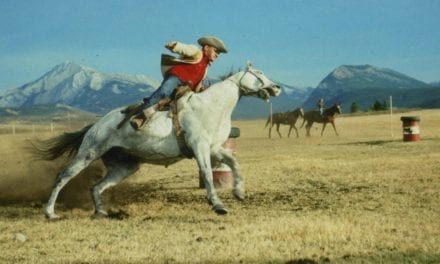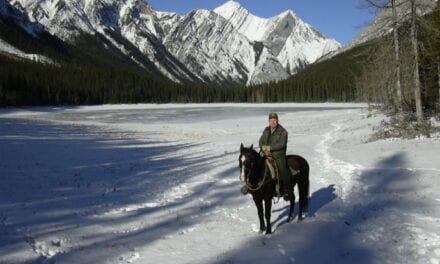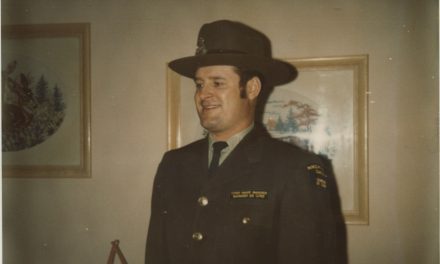(1:14:13) Equipment was the same way. Steve said, “You’ve got good men, you’ve got good material. You see to it that they are well equipped and I expect you to get the job done.” It was pretty near free hand in ordering and getting the equipment that we needed. Actually having Steve Kun made it work. The morale did come up and the guys got out and they did a good job.
(1:15:00) We had lots of things come up over time. One of them was the bear mauling. That was a good example of why the strength of the wardens was in the fact that they were all wardens, not all busted up like they are today. When we had the bear mauling there wasn’t any questions that would normally come up, like “He’s the bear man, let him look after it.” That whole aspect was just never there. The job descriptions never changed. They were all wardens, only their assignments changed. When you had a fire, or a search for a lost child, or you had a bear mauling or you had any of these things that cropped up on a regular basis sort of a thing everyone helped. Even on the rescue work, Walter used to depend on Jim Robertson. A big lanky cowboy, a great horseman, really no climber at all. Walter did get him up on a couple of mountain peaks. He roped him up and pulled him up there sort of a thing! But Jim was just super dependable as a ground man to ensure that the rescue operation was running (smoothly). Walter used to depend on him, but Jim was never considered one of the public safety team, but on large rescues Jim was in there somewhere. Wally McPhee was another one who was just great (on the ground).
(1:17:07) Jim (Robertson) also was about as good of a man as we had for tranquilizing. Jim could estimate the weight right to the pound of the bear or elk, or anything else we found… Although I doubt that he had more than a high school education, he had no problems at all understanding (the science behind tranquilization).
(1;17:41) Incidentally, George Balding’s daughter became paralyzed. She was in the hospital in Banff and this paralysis was going through her and it got up to the point where it was going to affect her heart and lungs, but the Doctor couldn’t find anything wrong. Jim (Robertson) came to the Doctor with his vet book and he pointed out that it had all the symptoms of Tick Spotted Fever. He had handled this in the south country with cattle and this sort of thing. But he also had the textbook on it. The Doctor said, ‘Well we’ll check it.” Nothing happened. He went back and they said, “We checked and there is no tick.” He insisted (that they check again), George was desperate at this time, and he insisted. And by God, the nurse rechecked and she had a pony tail and right in the spine under the pony tail was the tick! They removed it and she recovered.
(1:19:25) We used to have sheep to no end out by Norquay. You could count 20-30 sheep on the old highway. That whole area in the springtime it was just full (of sheep). We went out one time and took a white sheep and we just dragged it through the area, and it was loaded with ticks. They (ticks) really go for anything white. I guess that is because they go for the bodies of animals. At any rate, we never had the Rocky Mountain Spotted Fever, (in Banff). It was only reported in the south country. She (George Balding’s daughter) hadn’t been down in the south country. How that came about we never did know.
(1:20:21) (Andy was in Banff until he retired) I got two good retirement parties. A beautiful party at the (Banff) Springs. I had another one at the (Brewster) Donut shortly after for those who didn’t get to the Banff Springs. After I retired (from the Warden Service) I became the Environmental Coordinator on the highways. Then I had another retirement party, so I had three retirement parties!
(1:21:39) (Pointing to a painting) That one there is me and my saddle horse and she’s (the artist) got that saddle horse just down pat. That was June Mickle who did that painting. She gave me that at my retirement. I hired Donny (Mickle, June’s son) incidentally as a two man trail crew. That’s another little story. They turned the Trail Crews over to the General Works and General Works didn’t have the capabilities, so the wardens continued to do the trails, but the General Works was getting the credit from the public for it. That was when Steve Kun (the Superintendent), first came into Banff. This whole change had taken place (regarding) the wardens (responsibilities). I drew up on my map, and I said, “There is no reason why General Works cannot drive out to Scotch Camp and do the trails over the divide to the pass.” Which I knew would never happen. So I marked that trail in blue. Then I marked in red all the other trails they were not going to be doing. Steve Kun came up on a horse trip. It’s a horrible trail to start with. Fourteen creek crossings, not nice fords, a lot of it is grub hoed out. So anyhow, Steve came out and we bushwhacked through there and there was times that we had those horses skidding down on their rumps. We just really bushwhacked our way through it. Not a word out of Steve! When we got to the cabin at Indianhead. He said, “I’ll start supper while you do the horses.” I said, “That sounds like a great idea.” I was looking after the horses and after supper was over, he said “Well, what is your explanation for letting that trail get into that kind of shape?” I was ready for it and I handed him a map and I said, “That’s a General Work’s trail. We will ride on the red trails from here on…” We got back to Banff and Steve called a meeting and he asked me to come in for this meeting. The Engineer at that time was in Banff and he said, “Oh, we can’t hire people to go into those areas.” (I said) “The Warden Service, we had no problems. So it’s not a we thing, it’s a you thing.” He didn’t have any answer to that and Steve Kun turned around and said, “Can you hire people to do those trails?” I said, “Yes” This was pretty late in the summer. He said, ‘I will give you the authority. You go out and hire them.” So I went out to the Sundre Bar. I knew a bunch of the outfitters and that and I ended up with four of them. Their job was to take the horses and pack horses, which we would supply, and we would provide them with their living expenses and pay for their labor. The two brothers particularly that I hired were just top notch workers. The others didn’t produce as much but they still got out and covered the trails. They were able to stay in the cabins and look after fixing up the cabins, and doing things like that. It really worked great. It was the start of the two man trail crews.




Excellent history of what it was like to be a warden from Andy Anderson. Thanks for posting this story.